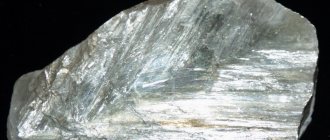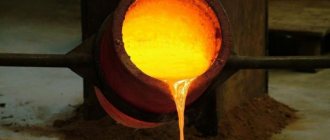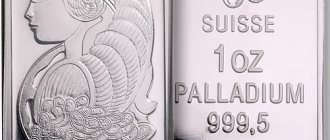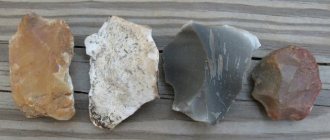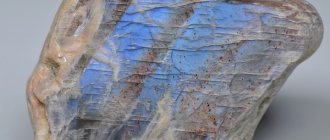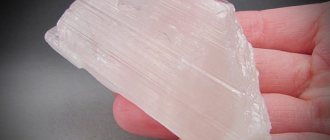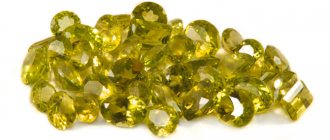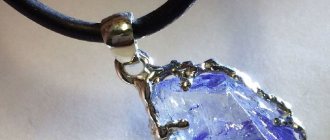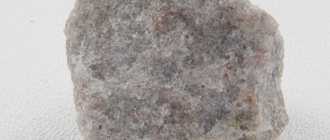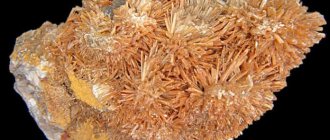Peridot stands out for its color variability. Under the influence of lighting, a stone can significantly change its shade. This not only attracted attention to it, but also became the reason for a careful study of its history of origin, as well as its magical properties. Over time, the material's popularity has waned, but it is still often used as an element of jewelry.
Peridot: description
This mineral is a variety of olivine (the latter is also commonly called peridot). In addition, the stone is called the “evening emerald”, which is justified by its color scheme. Precious green olivine has a strong oily sheen. The physical properties of chrysolite include:
- transparency partial or complete;
- granular, crystallized (prismatic shape);
- hardness 6.5-7 on the Mohs scale (quite brittle);
- dissolves in acids.
The material is easy to process, but also cracks easily. Therefore, only experienced jewelers work with this mineral. This also increases its price.
MORPHOLOGY
Peridot is usually distributed in granular aggregates. Well-formed crystals in voids (or embedded in metamorphic rocks) are relatively rare. The most characteristic forms (Fig. 281): {100}, {110}, {010}, {111}, {001}, etc. Twins are rare, mostly in (011).
In olivine basalts, large disseminated grains of peridot are recognizable by their dark greenish-yellow color, glassy sheen, and uneven fracture. Intrusive olivine rocks are characterized by paragenesis with magnesian silicates (serpentine, pyroxenes) and chrome spinels.
Origin story
Initially, the peridot variety became widespread among the Mongols. They discovered precious material among the rocks of the Khangai Highlands. According to their beliefs, the unusual green mineral was associated with dragons. Therefore, the Mongols believed that he had strong magical energy. It was used to protect the family and also to increase physical strength.
Helpful information
The stone was also popular among the Egyptians. It is believed that they were the ones who discovered this mineral. The name “peridot” was given to the material from the name of the island where the first samples were found.
Further, chrysolite gained great popularity in Europe and India. This highlighted the main magical property of the stone - the creation of internal harmony. From that moment on, jewelry began to be used for lithotherapy, and different types of stone began to be examined more closely. This led to the emergence of a classification.
Chrysolite was used by primitive people. It is assumed that the material was more common then. This is justified by the fact that it is predominantly of igneous origin. Since green olivine is easy to shape, it was often used to create tools and weapons.
Name compatibility
The properties and meaning of chrysolite determine its excellent combination with bright names that have deep roots and meaning for their bearer. This means that the name given to a person at birth is associated with an unusual event or person. The stone gives vital energy and helps men with the names:
- Eugene;
- Georgy;
- Stanislav;
- Oleg;
- Alexander;
- Innocent;
- Seraphim;
- Nikita;
- Dimitri;
- Adam.
Peridot will become a talisman for success and personal happiness, and will also reveal the inner potential of women with the following names:
- Evgenia;
- Oksana;
- Marina;
- Margarita;
- Valentina;
- Zlata;
- Zhanna;
- Flora;
- Bella.
What qualities does this mineral like in a person to become a talisman:
- Good nature;
- Emotionality;
- Determination;
- Talent;
- Thirst for knowledge and new experience;
- Persistence;
- Sincerity;
- Desire to help others.
Peridot and how to wear it:
- The best option is closer to the heart, in the form of pendants and pendants. This will free you from suffering and direct your energy in the right direction.
- Closer to the head - in the form of earrings, hairpins, piercings, etc. This will clear your head of bad thoughts and help you look at the world differently.
- On the hand (rings, bracelets, signets). This is how peridot encourages good luck and financial well-being.
- On the leg (bracelet). Strengthens connection with nature.
Where and how is stone mined?
The most famous deposit is the island of Zeberged, where peridot was first discovered. There is still quite a large accumulation of peridot there. In addition, the stone is often found in the following countries:
- USA;
- Australia;
- Pakistan;
- Republic of South Africa;
- Brazil;
- Afghanistan;
- Sri Lanka;
- Tanzania.
Russia, Mongolia, Myanmar, and Zaire are also involved in stone mining. Green olivine is usually found at great depths. It is often mined as a supplementary material. For example, chrysolite is found near diamond placers.
Peridot deposits
The “Russian Trade Book” mentions the berzat stone, and the oldest deposit of the golden-green gem was located on the island of Zebirget (Saint John), in the Red Sea, almost opposite the remains of the ancient city of Berenice. There is evidence that stones were mined there 3500 years ago. Mining then ceased and was briefly resumed in 1900. Currently not in use.
For history buffs: it was from this island (according to Pliny) that the gem “was first brought to Queen Berenice, who was the mother of the second Ptolemy, that the king liked it extremely much, and a statue of Arsinoe, Ptolemy’s wife, was created from it.”
In the Middle Ages, golden chrysolite was found in Silesia.
Currently, the stone is mined in several countries:
- Australia;
- Myanmar;
- Burma;
- Mexico;
- Tanzania;
- Vietnam;
- Afghanistan;
- SOUTH AFRICA;
- China.
Small quantities of the green mineral are found in Pakistan and Finland.
Russia can mine chrysolite in the Krasnoyarsk Territory and Yakutia.
Peridot stone has been found in some meteorites that have fallen to Earth.
Interesting: in 1749 a meteorite fell in Eastern Siberia. Peridot crystals were also found in it, which were cut. Gems still exist today.
The magic of peridot
The properties of this stone have always been associated with the Sun. Therefore, it is generally accepted that the mineral is especially effective when cut in gold. The magical properties of chrysolite primarily represent a strong protective effect. Because of this, this type of peridot is often used as a talisman. There is a whole list of positive effects:
- Effect on sleep. Relieves insomnia, nightmares, strange dreams.
- Regulation of emotions. Reduces envy and nervousness. Helps you relax and think more positively.
- Protects against dangerous events. Most often this refers to natural phenomena. The amulet is especially effective against fires.
- Improves mental health. Gives the owner confidence and self-esteem. Allows you to avoid depression and melancholy.
- Strengthens relationships. Positively affects any type of relationship. Thus, a product made from this material can help in friendship, love, and also improve relationships with enemies.
In addition, the stone is believed to be extremely beneficial for men. It helps them maintain self-esteem, preventing it from falling or rising above acceptable levels. The mineral also enhances passion.
Magical properties of the gem
In Armenian lapidariums, olivine was credited with the ability to protect against thunder and lightning.
In the Middle Ages, bracelets with chrysolite were worn by fast messengers. The stone was believed to strengthen endurance.
Among the magical properties of peridot is the ability to cleanse the owner of negative energy. And not only from those directed from the outside, but also from one’s own. For a person, this means liberation from feelings of guilt, old grievances, and disappointments. The golden-green radiance of the stone will help you not to blame others for your own mistakes, but to look for the reasons for your troubles within yourself. The gem will help you comprehend the past and move forward.
Peridot jewelry
The magic of the stone is useful for healers, esotericists, and students of spiritual practices.
We recommend: How is the purity of an emerald determined?
It is believed that the gem gives restful sleep and banishes nightmares.
Jewelry with chrysolite is suitable for businessmen, traders, and merchants.
Not proven: esotericists believe that a gem amulet will help win a lawsuit in court.
Healing properties of Chrysolite
Green olivine is used for lithotherapy, most often using powder. In addition, a similar form is added to the composition of various ointments. The stone has the following effects on the body:
- Is a pain reliever. Used to relieve headaches, discomfort in the liver, kidneys, stomach, spine, knees, gall bladder. The mineral is also believed to ease pain during childbirth.
- Recovery after severe mental or physical stress. Helps to recover faster from serious illnesses and stress.
- Getting rid of a number of diseases. Most often used in the treatment of infectious, eye, cardiovascular, and endocrine diseases.
As an element of ointment, chrysolite powder can have a positive effect on the condition of the skin. Previously, the stone was used to remove poisons from the body.
Areas of application of chrysolite
This semi-precious mineral is used exclusively for decoration. Jewelers combine it with many other materials to create various types of jewelry. However, this variety of peridot is no less popular as an element of clothing, dishes, and decorative items. It was often used when embroidering icons.
Peridot is not used in industry. This is justified by the fact that the material is too fragile for large-scale use. In addition, there are many less expensive analogues that are much easier to obtain.
Types of stone and their characteristics
Peridot is divided into several types, depending on its color and shine. It is important to consider that there is no strict division into types, so the mineral is divided exclusively by shades. Such a division is not exact, i.e. some stones can be classified into several groups. Some jewelers prefer to divide the stone into varieties based on origin, but this method is used less frequently. Based on color, chrysolite is divided into the following types:
- Rich green. It is one of the most popular shades. Such stones are sometimes confused with emeralds. Samples can be either light or dark in color.
- Pale green. This includes pistachio and olive representatives. They are the most common. Most often, such chrysolites are quite light.
- Yellow. Samples may be yellow, sometimes even mixed with red or brown. Such stones are considered rarer. Gold representatives are especially in demand.
Peridot mesa and star type are also distinguished separately. They may have different colors, but they have other unique features. Mesa stones are quarried by hand by Indian tribes and are also considered the largest. Star-shaped peridot is the rarest and most expensive, which is justified by its unusual shine.
Color variations
Sun in green
The description of the color of peridot is hidden in the name itself. The shine of the sun seemed to splash across the green surface of the mineral. It has a rare feature - it is presented by nature in only one color form.
However, the shades of green differ - light (yellow-green), grassy, emerald or olive. And there is definitely a golden tint, which is obtained due to magnesium, nickel and iron. The percentage of these microscopic particles regulates the color saturation.
In evening light, peridot becomes like a real emerald. And this is his color mystery. Under artificial light, there is no longer any gold; it disappears without a trace along with the rays of the sun. A deep rich emerald tone remains.
Edible shades
It was not by chance that chrysoprase was called the golden onion stone. Its color actually resembles the feathers of fresh green onions. All its shades are compared to edible plants.
The green apple color of chrysoprase comes from a certain percentage of nickel in the composition. A change in the quantitative content of this element in one direction or another creates dark or bluish tones. There are stones that look like lemons with a yellowish tint.
The most valuable are emerald-colored chrysoprases. For decorative purposes, specimens with natural heterogeneous coloring are highly valued.
How to care for peridot
Caring for the jewelry is standard. It should be taken into account that the mineral is sensitive to shock. It quickly breaks under physical influence, and it cannot be repaired. It is also recommended to follow several rules for caring for the product:
- Avoid contact with aggressive detergents and acids. This may negatively affect the color of the stone.
- Limit exposure to sunlight. Light can dull the color of the jewelry and cause cracks.
- When cleaning, the product must be wiped dry. Excess moisture can also deteriorate the appearance of the material.
The stone is washed with a gentle soap solution, and then dried with a napkin or towel. Dust can be removed with a soft cloth or brush.
How to distinguish a fake?
Due to the low cost of gems, they rarely become ornamental. But especially enterprising scammers have found a way to pass off colored glass as chrysolites. You don't need any special skills to check its authenticity. Here are some simple methods that you can implement while shopping in stores and at home:
- Place the stone in your hand. After some time in the palm of your hand, it should retain its previous temperature. This is the hallmark of all true minerals. If it quickly heats up and reaches body temperature, then this means that you have glass in front of you.
- The presence of uneven coloring of the specimen indicates its unnatural origin. Natural stones may have inclusions from other rocks and chemical elements, but in general the color will vary between yellow-green and bright green.
- In identifying a fake, the property of a cut mineral, when a ray of light is refracted, will bifurcate the image of an object that is located opposite it. If this does not happen, it is glass.
- An excessively large size of the stone (more than 1 cm) should alert you. Such large specimens are rare in nature, and if they are found, they are in the price category along with precious stones.
- Go shopping only to large jewelry stores, preferably chain stores. There, if you wish, you will be presented with the necessary documents on inspections and certification of products.
Peridot jewelry
Jewelers sell all types of products with peridot. However, earrings, necklaces, pendants, and pendants are considered the best options. This is justified by the fact that such jewelry is less susceptible to serious physical impact, due to which it can crack. At the same time, there are some design rules that most craftsmen adhere to:
- Despite the fact that green peridot belongs to semi-precious materials, it is often found in expensive settings. Usually it is white or red gold and silver of the highest standard. The frame can also be gold plated.
- Earrings are most often studs. In addition, the hanging type is common.
- Due to the complexity of processing, stone is often given natural shapes. This allows you to maintain the shine and purity of the material. It is important to know that peridot is rarely refined. The cut is usually step, brilliant, tabular or fancy. Star-shaped representatives, like other stones of this type, are decorated with the most convex cabochon.
The cut has a particularly strong influence on the final shade. The mineral is usually combined with other stones (usually white). The advantage of such jewelry is that they suit any style of clothing.
Imitation peridot
Although this variety of peridot does not have the highest price, it is often counterfeited. Most often glass is used for this, less often plastic.
Helpful information
Despite the fact that imitation also has a number of advantages, it has several significant disadvantages - inconsistency in appearance, lack of magical and healing effects, and even greater fragility. Therefore, it is recommended to purchase products made from natural materials.
To distinguish an artificial stone from a real one, you need to pay attention to the following distinctive features of a natural mineral:
- changes shade in different lighting;
- has a uniform color;
- heats up slowly;
- difficult to scratch.
In addition, a fake is usually cheaper than its natural counterpart. Artificial stones do not have cracks, inclusions or air bubbles.
Care and cleaning of jewelry
You need to care for peridot carefully - the stone is capricious.
When leaving, avoid:
- Hard mechanical cleaning.
- Jewelry falling from a height, blows.
- Ultrasonic and steam cleaning.
- Contacts with household chemicals and cosmetics.
Wearing jewelry with peridot to the bathhouse, sauna, or spa is not recommended.
Rinse the jewelry under running clean water and dry at room temperature.
Ring with peridot
Store jewelry in a separate box, box, or bag made of thick, soft fabric.
We recommend: Symbolism of AQUAMARINE STONE
Prices for chrysolite products
The cost of jewelry varies greatly, depending on the cut, size and color of the stones, as well as the setting. You can buy small processed beads of the most common color for 35 rubles. Stones are also often sold without settings. Their price ranges from 400 to 3000 rubles. In jewelry, a stone costs at least 2,500 rubles. It is extremely rare to find cheaper products with natural minerals (about 1500-2000 rubles). Many high-quality jewelry have a fairly high cost - 20,000-50,000 rubles.
Peridot and zodiac signs
Green olivine is highly friendly, so it is safe for any wearer. According to the zodiac sign, chrysolite is most suitable for Pisces. However, it can be effective for other zodiac signs as well. Before using a mineral, you should pay attention to the features of its effect:
- Fish. Protective properties are maximized. The amulet allows the owner to quickly make the right decisions and avoid difficult situations. In addition, it supports self-esteem, gives confidence, and also eliminates excessive nervousness, haste and shyness.
- Virgos. Hides bad qualities, significantly weakening them over time. Peridot and the Virgo zodiac sign go well together due to the fact that the stone has a strong effect on emotions. He restrains the impatience and impetuosity of his master. It also adds attractiveness, helps develop memory and attention.
- Lions. The amulet will help attract the attention of others and improve relationships with loved ones. Green peridot will positively affect a person’s character, making him more sensitive and understanding.
- Taurus. It weakens the negative qualities of this zodiac sign, such as excessive stubbornness, selfishness, and inattention to the feelings of others. The mineral allows such an owner to become more tolerant, which improves his relationships with loved ones.
- Scales. Decoration helps resolve family conflicts. In addition, it allows you to get rid of fears, melancholy, and depression. The stone makes the owner more positive and cheerful.
- Twins. The amulet will make mood swings less frequent. It will improve perseverance, attention, and also increase determination.
- Aries. Representatives of this sign are often quite ardent by nature, prone to strong uncontrollable emotions. Olivine will help you always keep your feelings under control, but will not weaken them.
- Capricorns. For such a wearer, chrysolite will be a good amulet. It can warn the owner about a possible danger or incorrect decision.
An amulet made from this material is not recommended for Pisces, Cancers, Aquarius, and Scorpios. While trying to help, a stone may accidentally harm its owner.
Stone compatibility table
Table of stones for Pisces, taking into account the Eastern horoscope (This table took into account the compatibility of the main stones depending on the year and month of birth, they will be ideal for both your Animal and your Sign).
| According to your horoscope you are: | Your stones: |
| Rat | Moonstone, Emerald, Heliotrope, Diamond |
| Bull | Tiger's Eye, Jade, Agate |
| Tiger | Diamond, Amethyst |
| Rabbit | Pearl, Carnelian |
| The Dragon | Amethyst, Sapphire, Peridot |
| Snake | Agate, Alexandrite, Jasper |
| Horse | Amethyst, Aquamarine, Agate |
| Goat | Emerald, Moonstone |
| Monkey | Opal, Aquamarine |
| Rooster | Aquamarine, Jasper |
| Dog | Agate, Tiger's Eye, Carnelian |
| Boar | Moonstone, Amethyst, Emerald |
Please leave a comment which stones you like and which one suits you best.
Interesting facts about chrysolite
Peridot has always attracted human attention, which has led to the creation of many legends. In addition, the stone has many names and was often used for a variety of purposes. Therefore, during the existence of chrysolite, many interesting facts about it have appeared. The most popular are:
- The mineral was previously often confused with topaz. Moreover, the name “topaz” supposedly comes from the name of the island of Topazios, where, as it turned out, chrysolites were mined.
- Although the stone has a list of names, only 3 options are considered official - peridot, peridot and olivine.
- It was believed that “Ural chrysolites” were mined in Russia. However, it later turned out that this is a much more valuable stone - demantoid garnet.
- During a volcanic eruption, this mineral can fall to the ground, remaining on the surface. This phenomenon is called chrysolite rain.
- In Hawaii you can see green beaches. It is olivine that gives sand this color.
It should also be noted that, despite the popularity of the material, it has still not been able to be grown, i.e., synthetic chrysolites do not exist.
